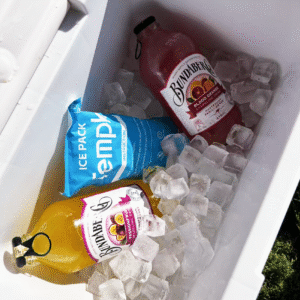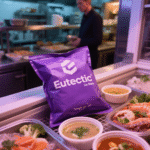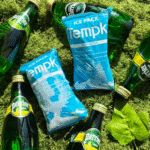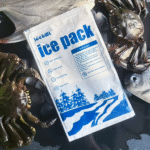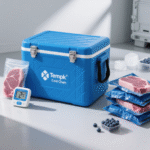Paquet de 6 Paquet de glace sec: 2025 Guide pratique
Si vous expédiez des marchandises surgelées, un pack of 6 paquet de glace sec gives you modular, ultra‑cold power with less waste and tighter control. Dry ice holds about –78 °C and leaves no meltwater, which protects quality and packaging. This guide shows you how to size, paquet, and label a pack of 6 dry ice pack—and what’s new in 2025—so your products arrive solid, sûr, et conforme.
-
Choose when a pack of 6 paquet de glace sec beats gel or PCM for deep‑freeze lanes
-
Calculate fast, field‑ready quantities with simple rules and a mini‑calculator
-
Paquet, étiquette, and vent correctly to pass checks the first time
-
Appliquer 2025 tendances (thin packs, emballages hybrides, smart logging) to save cost
Why does a pack of 6 dry ice pack deliver more even cooling?
Réponse directe:
Six smaller units surround your payload, cut hot spots, and stretch hold time. You can place packs above, autour, and below the goods, creating 360° cold. This even spread outperforms one large block, especially in parcel shippers with corners that warm first. Be sure you’re buying real glace carbonique, not hydratable “ice sheets” mislabeled as “dry ice packs.”
Deeper explanation:
Many listings say “dry ice pack” but actually sell water‑activated sheets or gel packs near 0 °C—great for chilled lanes, not for deep freeze. Real dry ice is solid CO₂ (UN1845), vents as gas, and requires hazard markings. Avec un pack of 6 paquet de glace sec, you tailor placement to your load and route, reserving one or two units for delays. That flexibility improves uniformity and reduces over‑cooling risk at edges.
Which long‑lasting setup should you start with?
Détails:
Begin with a “sandwich” layout: two under, two around, two on top. Pair with high‑R insulation (EPS or VIP) to slow heat gain and use less dry ice overall. VIP upgrades can cut dry ice needs by roughly a quarter in many lanes, then you tune down after a lane test with a data logger.
| Option de réfrigérant | Temp band | Durée typique (colis) | Ce que cela signifie pour vous |
|---|---|---|---|
| Paquet de 6 paquet de glace sec (Vrai co₂) | ~–78 °C | 24–72 h | Ultra‑cold, hazmat rules, best for frozen & biologique |
| Paquet de 6 hydratable “ice sheets” | 0–8 ° C | 24–48 h | Chilled only; not true dry ice; pas de danger
pack-of-6-dry-ice-pack-2025 |
| Panneaux PCM (–10 °C/–21 °C) | Congelé | 24–96 h | Stable temps, réutilisable; pair with dry ice for long hauls |
Conseils pratiques que vous pouvez utiliser aujourd'hui
-
Small parcels: surround payload; keep voids under 15% to curb convection.
-
Améliorer l'isolation: VIP or thicker EPS lowers dry ice mass 20–30% in many routes.
-
Confirm the product: “UN1845” → real dry ice; “soak in water/24‑cell” → hydratable sheet.
pack-of-6-dry-ice-pack-2025
Caisse de terrain: A microcreamery placed four packs around pints and two on top inside an EPS shipper; pints arrived rock‑solid after 48 hours with less weight than prior blocks.
How do you size a pack of 6 dry ice pack for 24–72 hours?
Réponse directe:
Use 5–10 lb of dry ice per 24 h for frozen parcels as a conservative start; scale by payload, isolation, chaleur ambiante, and duration. If each pack is ~1 lb, 48 h often needs 4–6 packs in EPS; hot lanes may add 20%. Always verify with a lane test.
Deeper explanation:
Mass matters more than “how many.” Confirm unit weight, then estimate by day and lane stress, not just by count. Pre‑freeze the payload to reduce the cooling load. Better insulation cuts mass, and hybrid layouts (some dry ice + some PCM) extend time without over‑freezing sensitive SKUs.
Fast calculator for a pack of 6 paquet de glace sec
Use this starter formula, then validate in a pilot:
Conseil: If each unit is 1 kg, eighteen pounds means three full 6‑packs—or upgrade insulation to reduce mass.
| Estimateur | 24 h | 48 h | Ce que cela signifie pour vous |
|---|---|---|---|
| 5 lb rule (mild) | 5 kg | 10 kg | Light loads, Bon EPS, short lanes |
| 7.5 lb mid | 7.5 kg | 15 kg | Typical starting point |
| 10 lb hot | 10 kg | 20 kg | Hot lanes or long dwell time |
| Tighten after three monitored shipments. |
Comment emballer, étiquette, and ship a pack of 6 dry ice pack safely?
Réponse directe:
Marchandises avant la référence, use high‑R insulation, distribute packs 360°, laisser un chemin de ventilation, and mark UN1845 with net weight. Add a temperature logger and follow operator variations for air cargo.
Deeper explanation:
Dry ice off‑gasses CO₂, so airtight boxes are unsafe. Vent through designed paths. Pour l'air, follow IATA PI 954 markings; passenger baggage typically limits dry ice to 2.5 kg per person. USPS domestic air mail has strict limits; international mail prohibits dry ice. Label “Carbon dioxide, solide (Glace sèche), UN1845” and include net weight.
Compliance snapshot for 2025
-
Voici pi954: emballage ventilé, proper marking, operator caps may apply.
-
Vols de passagers: ~2.5 kg per person when approved and vented.
-
USPS (air): domestic allowed under limits; International interdit.
User‑ready packing checklist
-
Freeze to the core: pre‑condition products; “cold starts” eat dry ice.
-
Remplir les vides: dunnage reduces warm pockets and sublimation.
-
Haut + côtés: place some mass above goods; cold sinks uniformly.
-
Peser & enregistrer: put net dry ice on the label for acceptance.
Real‑world: A gene‑therapy shipment using a VIP shipper plus a pack of 6 paquet de glace sec and a logger held ~–65 °C for ~60 h while using ~25% less dry ice than before.
Who should use a pack of 6 dry ice pack—and when not?
Réponse directe:
Food brands, kits de repas, biotech labs, and clinics benefit most when parcel sizes vary and delays happen. A pack of 6 paquet de glace sec lets you dial cooling up or down per order. If you only ship chilled (2–8 ° C), hydratable sheets or PCM may be simpler.
Deeper explanation:
Six units scale with order volume and protect edges in mixed‑SKU boxes. For long hauls, consider hybrid packouts (some dry ice + PCM) to steady temps and cut total CO₂. Upgrade liners or VIP when lanes run hot or long.
2025 cold‑chain developments that affect a pack of 6 paquet de glace sec
Aperçu de la tendance:
Thin dry ice packs increase space for payload while maintaining ultra‑cold performance for longer windows. IoT temperature/CO₂ loggers and smarter SOPs are now standard. The dry ice market continues to expand with more captured‑CO₂ feedstock and sustainability targets.
Dernier progrès en un coup d'œil
-
Thin packs: slimmer form factors free space and can extend useful hold time.
-
Surveillance intelligente: Bluetooth/IoT loggers flag temp or gas spikes in real time.
-
Emballages hybrides: mixing PCM and dry ice reduces CO₂ mass while extending holds.
Perspicacité du marché:
Expect tighter carrier acceptance checks and supply swings in CO₂; diversify suppliers and reduce consumption via better insulation and pack planning. Asia‑Pacific demand rises with exports and healthcare growth; VIP reuse programs support cost control.
FAQ
How long can a pack of 6 dry ice pack last?
24–72 h in well‑insulated parcels, lane‑dependent; thin packs and hybrid layouts can add time.
Is a pack of 6 dry ice pack the same as “ice sheets”?
Non. Many “ice sheets” are hydratable near 0 °C; real dry ice is solid CO₂ at ~–78 °C and is regulated.
pack-of-6-dry-ice-pack-2025
What’s a quick sizing rule?
Commencer par 5–10 lb par 24h pour les voies surgelées, then tune by logger data and insulation.
Can I fly with a pack of 6 paquet de glace sec?
Yes with limits: passenger baggage is typically 2.5 kg per person if vented and labeled. Vérifier les variations de l'opérateur.
Do I need to vent the box?
Oui. Co₂ doit s'échapper. Never use an airtight container with dry ice.
Résumé & recommandations
Points clés:
UN pack of 6 paquet de glace sec gives modular, even cooling for frozen shipments. Size by mass per day, upgrade insulation to cut usage, and pack 360° with vents open. Add a logger, label UN1845 with net weight, and run a three‑shipment pilot to tune down cost.
Étapes suivantes (CTA):
-
Define temp band and hours.
-
Start with the 5–10 lb/day rule.
-
Upgrade insulation or try hybrid layouts if mass is high.
-
Parler à tempk for a sizing plan and sample kit.
À propos du tempk
We design practical cold‑chain systems—dry ice packs, PCM, EPS/VIP shippers—that balance performance, coût, et durabilité. Our thin‑pack research, captured‑CO₂ sourcing, and easy SOPs help you hit temperature with less mass and fewer claims.
Contact us to plan your next lane test.






